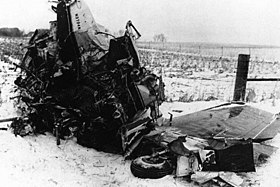 The wreckage of the Bonanza at the crash site The wreckage of the Bonanza at the crash site | |
| Accident | |
|---|---|
| Date | February 3, 1959; 65 years ago (1959-02-03) |
| Summary | Crashed following loss of control in poor weather at night |
| Site | Grant Township, Cerro Gordo County, Iowa, U.S. 43°13′13.3″N 93°22′53.1″W / 43.220361°N 93.381417°W / 43.220361; -93.381417 |
| Aircraft | |
| Aircraft type | Beechcraft Bonanza |
| Operator | Dwyer Flying Service, Mason City, Iowa, U.S. |
| Registration | N3794N |
| Flight origin | Mason City Municipal Airport, Iowa, U.S. |
| Destination | Hector Airport, North Dakota, U.S. |
| Occupants | 4 |
| Passengers | 3 |
| Crew | 1 |
| Fatalities | 4 |
| Survivors | 0 |
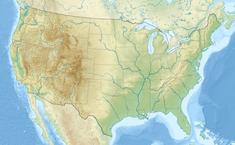
On February 3, 1959, American rock and roll musicians Buddy Holly, Ritchie Valens, and "The Big Bopper" J. P. Richardson were all killed in a plane crash near Clear Lake, Iowa, together with pilot Roger Peterson. The event became known as "The Day the Music Died" after singer-songwriter Don McLean referred to it as such in his 1971 song "American Pie".
At the time, Holly and his band, consisting of Waylon Jennings, Tommy Allsup, and Carl Bunch, were playing on the "Winter Dance Party" tour across the American Midwest. Rising artists Valens, Richardson and vocal group Dion and the Belmonts had joined the tour as well. The long journeys between venues on board the cold, uncomfortable tour buses adversely affected the performers, with cases of flu and even frostbite.
After stopping at Clear Lake to perform, and frustrated by the conditions on the tour buses, Holly chose to charter a plane to reach their next venue in Moorhead, Minnesota. Richardson, suffering from flu, swapped places with Jennings, taking his seat on the plane, while Allsup lost his seat to Valens on a coin toss. Soon after takeoff, late at night and in poor, wintry weather conditions, pilot Peterson lost control of the light aircraft, a Beechcraft Bonanza, which crashed into a cornfield, killing all four on board.
The event has since been mentioned or referenced in various media. Various monuments have been erected at the crash site and in Clear Lake, where an annual memorial concert is held at the Surf Ballroom, the venue that hosted the artists' last performances.
Background
In November 1958, Buddy Holly terminated his association with The Crickets. According to Paul Anka, Holly realized he needed to go back on tour again for two reasons: he needed cash because the Crickets' manager Norman Petty had apparently stolen money from him, and he wanted to raise funds to move to New York City to live with his new wife, María Elena Holly, who was pregnant (although he already lived in New York when he started the tour). Holly signed up with General Artists Corporation (GAC) because "he knew they were planning a British tour and he wanted to be in on that."
For the start of the "Winter Dance Party" tour, Holly assembled a band consisting of Waylon Jennings (bass), Tommy Allsup (guitar) and Carl Bunch (drums), with the opening vocals of Frankie Sardo. The tour was set to cover twenty-four Midwestern cities in as many days—there were no off days. New hit artist Ritchie Valens, "The Big Bopper" J. P. Richardson and the vocal group Dion and the Belmonts joined the tour to promote their recordings and make an extra profit.

The tour began in Milwaukee on January 23, 1959, with the performance in Clear Lake, Iowa on February 2 being the eleventh of the twenty-four scheduled events. The amount of travel required soon posed a serious problem. The distances between venues had not been properly considered when the performances were scheduled. Instead of systematically circling around the Midwest through a series of venues in close proximity to one another, the tour erratically zigzagged back and forth across the region, with distances between some tour stops exceeding 400 miles (640 km). As there were no off days, the bands had to travel most of each day, frequently for ten to twelve hours in freezing mid-winter temperatures. Most of the Interstate Highway System had not yet been built, so the routes between tour stops required far more driving time on narrow two-lane rural highways than would now be the case on modern expressways.
GAC, which booked the tour, received considerable criticism for their seemingly total disregard for the conditions they forced the touring musicians to endure:
They didn't care. It was like they threw darts at a map ... The tour from hell—that's what they named it—and it's not a bad name.
— Bill Griggs, music historian and founder of the Buddy Holly Memorial Society
The entire company of musicians traveled together in one bus, although the buses used for the tour were wholly inadequate, breaking down and being replaced frequently. Griggs estimates that five separate buses were used in the first eleven days of the tour—"reconditioned school buses, not good enough for school kids." The artists themselves were responsible for loading and unloading equipment at each stop, as no road crew assisted them. Adding to the disarray, the buses were not equipped for the harsh weather, which consisted of waist-deep snow in several areas and varying temperatures from 20 °F (−7 °C) to as low as −36 °F (−38 °C). One bus had a heating system that malfunctioned shortly after the tour began in Appleton, Wisconsin.
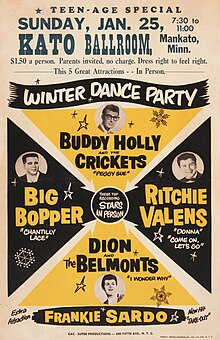
Richardson and Valens began experiencing flu-like symptoms, and drummer Bunch was hospitalized for severely frostbitten feet, after the tour bus stalled in the middle of the highway in subzero temperatures near Ironwood, Michigan. The musicians replaced that bus with another school bus and kept traveling. As Holly's group had been the backing band for all of the acts, Holly, Valens and DiMucci (and Carlo Mastrangelo of the Belmonts who was a drummer) took turns playing drums for each other at the performances in Green Bay, Wisconsin, and Clear Lake, Iowa, with Holly playing drums for Dion, Dion playing drums for Ritchie, and Ritchie playing drums for Holly.
On Monday, February 2, the tour arrived in Clear Lake, west of Mason City, Iowa, having driven 350 miles (560 km) from the previous day's concert in Green Bay. Clear Lake had not been a scheduled stop; tour promoters hoped to fill the open date and called Carroll Anderson, the manager of the local Surf Ballroom, and offered him the show. Anderson accepted and they set the show for that night. By the time Holly arrived at the venue that evening, he was frustrated with the ongoing problems with the bus. The next scheduled destination after Clear Lake was Moorhead, Minnesota, a 365-mile (590 km) drive north-northwest—and, as a reflection of the poor quality of the tour planning, a journey that would have taken them directly back through the two towns they had already played within the last week. No respite was in sight after that, as the following day, after having traveled from Iowa to Minnesota, they were scheduled to travel back to Iowa, specifically almost directly south to Sioux City, a 325-mile (520 km) trip.
Holly chartered a plane to fly himself and his band to Fargo, North Dakota, which is adjacent to Moorhead. The rest of the party would have picked him up in Moorhead, saving him the journey in the bus and leaving him time to get some rest. Their gig in Moorhead was to have been a radio performance at the station KFGO with disc jockey Charlie Boone.
Flight arrangements

Anderson chartered a plane from Dwyer Flying Service in Mason City, to fly to Fargo's Hector Airport, the closest airport to Moorhead; the pilot was Roger Peterson, a 21-year-old married man who had "built his life around flying".
Dwyer Flying Service charged a fee of $36 (equivalent to $380 in 2023) per passenger for the flight on the 1947 single-engined, V-tailed Beechcraft 35 Bonanza (registration N3794N), which seated three passengers and the pilot. A popular misconception, originating from Don McLean's song about the crash, was that the plane was called American Pie; no record exists of any name ever having been given to N3794N.
The most widely accepted version of events was that Richardson had contracted the flu during the tour and asked Jennings for his seat on the plane. When Holly learned that Jennings was not going to fly, he said in jest: "Well, I hope your damned bus freezes up." Jennings responded: "Well, I hope your ol' plane crashes", a humorous but ill-fated response that would haunt Jennings for the rest of his life. Valens, who once had a fear of flying, asked Allsup for his seat on the plane. The two agreed to toss a coin to decide. Bob Hale, a disc jockey with Mason City's KRIB-AM, was emceeing the concert that night and flipped the coin in the ballroom's side-stage room shortly before the musicians departed for the airport. Valens won the coin toss for the seat on the flight. Valens is apocryphally said to have remarked, "That's the first time I've ever won anything in my life."
In contradiction to the testimony of Allsup and Jennings, Dion has since said that Holly approached him along with Valens and Richardson to join the flight, not Holly's bandmates. In a 2009 interview, Dion said that Holly called him, Valens and Richardson into a vacant dressing room during Sardo's performance and said, "I've chartered a plane, we're the guys making the money ...the only problem is there are only two available seats." According to Dion, it was Valens, not Richardson, who had fallen ill, so Valens and Dion flipped a coin for the seat. In his interview, no mention is made of Jennings or Allsup being invited on the plane. Dion said he won the toss, but ultimately decided that since the $36 fare equaled the monthly rent his parents paid for his childhood apartment, he could not justify the indulgence.
Take-off and crash
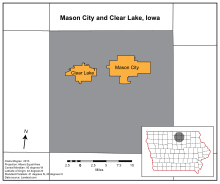
After the show ended, Anderson drove Holly, Valens and Richardson to nearby Mason City Municipal Airport, where the elevation is 1,214 feet (370 m) AMSL. The weather at the time of departure was reported as light snow, a ceiling of 3,000 feet (900 m) AMSL with sky obscured, visibility six miles (10 km) and winds from 20 to 30 mph (17 to 26 kn; 32 to 48 km/h; 8.9 to 13.4 m/s). Although deteriorating weather was reported along the planned route, the weather briefings Peterson received failed to relay the information.
The plane took off normally from runway 17 (today's runway 18) at 00:55 (12:55 am) CST on Tuesday, February 3. Hubert Jerry Dwyer, owner of the flying service, watched the southbound take-off from a platform outside the control tower. He was able to clearly see the aircraft's tail light for most of the brief flight, which started with an initial 180 degree left turn to pass east of the airport, climbing to approximately 800 feet (240 m) AGL. After an additional left turn to a northwesterly heading, the tail light was observed gradually descending until it disappeared. Around 1 am, when Peterson failed to make the expected radio contact, repeated attempts were made to establish radio contact, without success. Later that morning at daylight, after several attempts to contact the plane were unsuccessful, Dwyer retraced Peterson's planned route by air, and around 9:35 am he spotted the wreckage less than six miles (10 km) northwest of the airport.
The Bonanza had impacted terrain at high speed, estimated to have been around 170 mph (150 kn; 270 km/h), banked 90° to the right and in a nose-down attitude. The right-wing tip struck the ground first, gouging a 12-by-2-foot-deep (4 m × 1 m) furrow, crumpling then breaking off. The fuselage then hit the ground right-side down and bounced a few feet back into the air, traveling another 50 feet (17 yd; 15 m) through the air, simultaneously rolling inverted due to the remaining left wing still generating lift. The plane struck the ground a final time, in an inverted, nose-down position, the nose hitting and flipping the plane over into a right-side up, tail-first position. The momentum of the heavy engine caused the fuselage, left wing remaining attached and intact to the end, to roll upon itself into a virtual ball, rolling nose-over-tail across the frozen field for 540 feet (180 yd; 160 m), before coming to rest tail-first against a wire fence. The bodies of the performers had been ejected from the fuselage and lay near the plane's wreckage, while Peterson's body, which was entangled in the wreckage, could only be retrieved after the cockpit was cut open using blowtorches. With the rest of the entourage en route to Minnesota, Anderson, who had driven the party to the airport and witnessed the plane's takeoff, had to identify the bodies of the musicians. The county coroner, Ralph Smiley, reported that all four victims died instantly, the cause of death being "gross trauma to brain" for the three musicians and "brain damage" for the pilot.
Aftermath
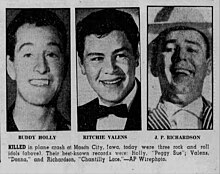
María Elena Holly learned of her husband's death via a television news report. A widow after only six months of marriage, she suffered a miscarriage shortly after, reportedly due to "psychological trauma". Holly's mother, on hearing the news on the radio at home in Lubbock, Texas, screamed and collapsed.
Despite the tragedy, the "Winter Dance Party" tour continued. Fifteen-year-old Bobby Vee was given the task of filling in for Holly at the next scheduled performance in Moorhead, in part because he "knew all the words to all the songs." Jennings and Allsup carried on for two more weeks, with Jennings taking Holly's place as lead singer. Other performers who were recruited for the remainder of the tour were Jimmy Clanton, Fabian and Frankie Avalon.
Meanwhile, funerals for the victims were held individually. Holly and Richardson were buried in Texas, Valens in California and Peterson in Iowa. Holly's widow, María Elena, did not attend his funeral. She said in an interview: "In a way, I blame myself. I was not feeling well when he left. I was two weeks pregnant, and I wanted Buddy to stay with me, but he had scheduled that tour. It was the only time I wasn't with him. And I blame myself because I know that, if only I had gone along, Buddy never would have gotten into that airplane."
Official investigation
The official investigation was carried out by the Civil Aeronautics Board (CAB, precursor to the NTSB). It emerged that Peterson had over four years of flying experience, of which one was with Dwyer Flying Service, and had accumulated 711 flying hours, of which 128 were on Bonanzas. He had also logged 52 hours of instrument flight training, although he had passed only his written examination, and was not yet qualified to operate in weather that required flying solely by reference to instruments. Peterson and Dwyer Flying Service itself were certified to operate only under visual flight rules, which essentially require that the pilot must be able to see where the aircraft is going. On the night of the accident visual flight would have been virtually impossible due to the low clouds, the lack of a visible horizon and the absence of ground lights over the sparsely populated area.
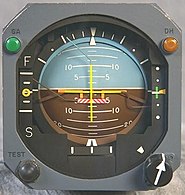 A conventional artificial horizon: sky on top, ground at the bottom
A conventional artificial horizon: sky on top, ground at the bottom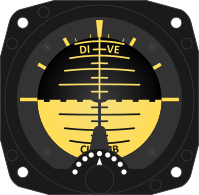 A Sperry F3 attitude gyroscope: ground on top, sky at the bottom
A Sperry F3 attitude gyroscope: ground on top, sky at the bottom
Furthermore, Peterson, who had failed an instrument checkride nine months before the accident, had received his instrument training on airplanes equipped with a conventional artificial horizon as a source of aircraft attitude information, while the accident aircraft was equipped with an older-type Sperry F3 attitude gyroscope. Crucially, the two types of instruments display the same aircraft pitch attitude information in graphically opposite ways. As a result, when the aircraft took off, Peterson, observing the older model Sperry F3 gyroscope, thought he was climbing when in fact he was descending.
Another contributing factor was the "seriously inadequate" nighttime weather briefing provided to Peterson, which "failed to even mention adverse flying conditions which should have been highlighted". The CAB concluded that the probable cause of the accident was "the pilot's unwise decision" to attempt a flight at night that required skills he did not have.
Subsequent investigations
On March 6, 2007, in Beaumont, Texas, Richardson's body was exhumed for reburial. Forest Lawn Cemetery moved his body to a more suitable area after plans were made to erect a bronze statue near his gravesite to accompany a newly received historical marker. As the body was to be placed in a new casket while above ground, the musician's son, Jay Perry Richardson, took the opportunity to have his father's body re-examined to verify the original coroner's findings and asked forensic anthropologist William M. Bass to carry out the procedure.
A longstanding rumor surrounding the accident, which this re-examination sought to confirm or dispel, asserted that an accidental firearm discharge took place on board the aircraft and caused the crash. It had also been speculated that Richardson initially survived the crash and crawled out of the wreckage in search of help before succumbing to his injuries, prompted by the fact that his body was found farther from the plane than the other victims. Bass and his team took several X-rays of Richardson's body and eventually concluded that the musician had indeed died instantly from extensive, unsurvivable fractures to virtually every bone in his body. No traces of lead were found from any bullet, nor any indication that he had been shot. Coroner Smiley's original 1959 report was, therefore, confirmed as accurate.
In March 2015, the NTSB received a request to reopen the investigation into the accident. The request was made by L. J. Coon, a retired pilot from New England who felt that the conclusion of the 1959 investigation was inaccurate. Coon suspected a possible failure of the right ruddervator, or a problem with the fuel system, as well as possible improper weight distribution. Coon argued that Peterson may have tried to land the plane and that his efforts should be recognized. The NTSB declined the request in April 2015, saying that the evidence presented by Coon was insufficient to merit the reconsideration of the original findings.
Legacy
Policies
A policy not to report on a person's death until their family had been notified was implemented by authorities in the months after María Elena Holly suffered her miscarriage due to the psychological trauma of hearing about her husband's death on television for the first time.
Memorials
A memorial service for Peterson was held at Redeemer Lutheran Church in Ventura, Iowa, on February 5. A funeral was held the next day at St. Paul Lutheran Church in his hometown of Alta; Peterson was buried in Buena Vista Memorial Cemetery in nearby Storm Lake.
Films
- The accident closes the biographical film The Buddy Holly Story (1978); the film ends as the Clear Lake concert concludes, and a freeze-frame shot is followed with a caption revealing their deaths later that night "...and the rest is Rock 'N Roll."
- The run-up to the accident (which happens entirely off-camera) and its aftermath, particularly the reactions of Ritchie Valens' immediate family and loved ones, are depicted in the Valens biopic La Bamba (1987).
Memorial concerts
Fans of Holly, Valens, and Richardson have been gathering for annual memorial concerts at the Surf Ballroom in Clear Lake since 1979. The fiftieth anniversary concert took place on February 2, 2009, with Delbert McClinton, Joe Ely, Wanda Jackson, Los Lobos, Chris Montez, Bobby Vee, Graham Nash, Peter and Gordon, Tommy Allsup, and a house band featuring Chuck Leavell, James "Hutch" Hutchinson, Bobby Keys, and Kenny Aronoff. Jay Perry Richardson, the son of the Big Bopper, was among the participating artists, and Bob Hale was the master of ceremonies, as he was at the 1959 concert.
Monuments
In June 1988, a 4-foot (1.2 m) tall granite memorial bearing the names of Peterson and the three entertainers was dedicated outside the Surf Ballroom with Peterson's widow, parents, and sister in attendance; the event marked the first time that the families of Holly, Richardson, Valens, and Peterson had gathered together.
In 1989, Ken Paquette, a Wisconsin fan of the 1950s era, made a stainless-steel monument that depicts a guitar and a set of three records bearing the names of the three performers killed in the accident. The monument is on private farmland, about 1⁄4 mi (1,300 ft; 440 yd; 400 m) west of the intersection of 315th Street and Gull Avenue, five miles (8 km) north of Clear Lake. At that intersection, a large plasma-cut steel set of Wayfarer-style glasses, similar to those Holly wore, marks the access point to the crash site.
Paquette created a similar stainless-steel monument to the three musicians located outside the Riverside Ballroom in Green Bay, Wisconsin, where Holly, Richardson, and Valens played their penultimate show on February 1. This second memorial was unveiled on July 17, 2003. In February 2009, a further memorial made by Paquette for Peterson was unveiled at the crash site.
-
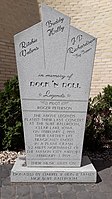 Monument in front of the Surf Ballroom in Clear Lake, Iowa
Monument in front of the Surf Ballroom in Clear Lake, Iowa
-
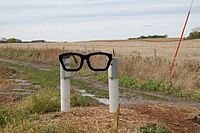 Signpost east of the crash site replicating Holly's signature glasses. The crash site is actually located 1,850 feet (617 yd; 564 m) from this location, down the path along the fence line.
Signpost east of the crash site replicating Holly's signature glasses. The crash site is actually located 1,850 feet (617 yd; 564 m) from this location, down the path along the fence line.
-
Memorial at crash site, 2024
-
Memorial to pilot Roger Peterson at crash site
Roads
A road originating near the Surf Ballroom, extending north and passing to the west of the crash site, is now known as Buddy Holly Place.
Songs

Problems playing this file? See media help.
- Tommy Dee recorded "Three Stars" (1959), commemorating the musicians.
- In 1961, Mike Berry recorded "Tribute to Buddy Holly", which describes the night of the flight. It reached number 24 on the UK Singles Chart and was notoriously banned by the BBC for being "too morbid".
- Don McLean, a fan of Buddy Holly, addressed the accident in his song "American Pie" (1971), dubbing it "the Day the Music Died", which for McLean symbolized the "loss of innocence" of the early rock-and-roll generation.
- In 1978, Waylon Jennings briefly added his own memories of the incident onto his song "A Long Time Ago", from the album I've Always Been Crazy. He sings the lines "Don't ask me who I gave my seat to on that plane, I think you already know, I told you that a long time ago."
- Dion recorded "Hug My Radiator" which references the "broken-down bus" and the chilling cold the performers experienced on the tour. The song does not directly reference the three performers who died, but Dion has said, in interviews, that the song is a memory of the tour and that he almost got on the airplane that crashed, but it was too expensive.
- In 1985, German punk rock band Die Ärzte released their second album Im Schatten der Ärzte, which includes the song Buddy Holly's Brille. In their trademark humorous fashion, they treat the accident by asking where Holly's glasses ended up.
Fiction
Howard Waldrop's short story "Save a Place in the Lifeboat for Me" (collected in Howard Who?) describes a fictional attempt by a sextet of famous slapstick characters (Chico and Harpo Marx, Abbott and Costello, and Laurel and Hardy) to prevent the accident from occurring.
TJ Klune's 2020 fantasy novel "The House in the Cerulean Sea" features an orphaned antichrist, Lucy, who collects records of Holly, the Big Bopper, and Valens, and discusses the crash with the protagonist, Linus.
See also
- List of music group or artist fatalities from aviation accidents
- Continued VFR into IMC
- American Airlines Flight 320 - A commercial flight that crashed while attempting to land at LaGuardia Airport in New York City, killing 65 of the 73 people on board, on the same day as Holly's death.
Notes
- This was one of three notable aviation incidents to occur on this date; the other two were the crash of American Airlines Flight 320 in New York City (which knocked the story of the Clear Lake crash down the headlines in the newspapers) and the near crash of Pan Am Flight 115 near Newfoundland.
References
Citations
- "Rock 'n' roll singers die in air crash". Eugene Register-Guard. (Oregon). Associated Press. February 3, 1959. p. 1A. Archived from the original on August 12, 2021. Retrieved October 3, 2020.
- "Stars of rock 'n' roll troupe die in crash which claims 4 lives". Bend Bulletin. (Oregon). UPI. February 3, 1959. p. 1. Archived from the original on August 12, 2021. Retrieved October 3, 2020.
- Anka, Paul; Dalton, David (2013). My Way: An Autobiography. New York: St. Martin's Press. p. 88. ISBN 9781250035202. Archived from the original on April 12, 2023. Retrieved October 9, 2020.
- Anka, Paul; Dalton, David (2013). My Way: An Autobiography. New York: St. Martin's Press. p. 90. ISBN 9781250035202. Archived from the original on April 12, 2023. Retrieved October 9, 2020.
- ^ Suddath, Claire (February 3, 2009). "The Day the Music Died". Time. Archived from the original on August 26, 2013. Retrieved December 22, 2020.
- Everitt 2004, p. 10.
- Lehmer 2004, p. 82.
- ^ Huey, Pamela (February 3, 2009). "Buddy Holly: The tour from hell". Star Tribune. Archived from the original on August 15, 2020.
- ^ Everitt 2004, p. 13.
- "Connection to Buddy Holly Death". WeGoNews.com. Archived from the original on August 27, 2010. Retrieved December 22, 2020.
- ^ Everitt 2004, p. 14.
- ^ Durfee, James R.; Gurney, Chan; Denny, Harmar D.; Minetti, G. Joseph; Hector, Louis J. (September 23, 1959). Aircraft Accident Report (PDF) (Report). Civil Aeronautics Board. Archived from the original (PDF) on February 26, 2009. Retrieved February 4, 2009.
- "FAA Registry (N3794N)". Federal Aviation Administration.
- Schuck, Raymond 2012, p. 16.
- "American Pie". Snopes.com. March 13, 2000. Archived from the original on March 22, 2021. Retrieved April 16, 2015.
- "The Day the Music Died: Remembering The Lives Lost". Beyond the Dash. January 25, 2021. Archived from the original on February 10, 2024. Retrieved March 15, 2021.
- Jennings & Kaye 1996, p. 70.
- McArdle, Terence (January 12, 2017). "Tommy Allsup, guitarist who backed Buddy Holly, Kenny Rogers and others, dies at 85". The Washington Post. Archived from the original on January 13, 2017. Retrieved March 21, 2024.
- DiMucci, Dion (1988). The Wanderer. Beech Tree Books. p. 89.
- Everitt 2004, p. 15.
- Everitt 2004, p. 16.
- Everitt 2004, p. 17.
- (February 4, 1959) "3 Rock, Roll Stars Killed in Air Crash", Anderson Herald. pg.3. United Press International. Retrieved February 6, 2024.
- Everitt 2004, p. 21.
- "Death certificates" (PDF). Awesome Stories. Archived (PDF) from the original on March 4, 2016. Retrieved June 1, 2015.
- "Coroner's investigation" (PDF). Awesome Stories. Archived (PDF) from the original on March 4, 2016. Retrieved June 1, 2015.
- "Bobby Vee Biography". bobbyvee.net. Paragraph 3. Archived from the original on January 29, 2019. Retrieved December 22, 2020.
- Carr & Munde 1997, p. 155.
- Genetti, Domenic (February 2, 2024). "Winter Dance Party's resilience after plane crash killed Buddy Holly, Ritchie Valens, The Big Bopper". Beaumony Enterprise. Retrieved May 14, 2024.
- McLean, Craig (February 1, 2019). "'He knew he was going to die': Buddy Holly's widow on keeping his memory alive". The Telegraph. ISSN 0307-1235. Archived from the original on January 12, 2022. Retrieved May 28, 2020.
- Kerns, William (August 15, 2008). "Buddy and Maria Elena Holly married 50 years ago". Lubbock Avalanche-Journal. Archived from the original on March 23, 2016. Retrieved April 29, 2015.
- Griggs, Bill. "Big Bopper Exhumation". Archived from the original on July 7, 2012. Retrieved April 26, 2015.
- "Autopsy of 'Big Bopper' to Address Rumors About 1959 Plane Crash". The Washington Post. January 18, 2007. ISSN 0190-8286. Archived from the original on June 28, 2011. Retrieved April 26, 2015.
- "Board considers reopening investigation into plane crash that caused the death of Buddy Holly". KITV. March 3, 2015. Archived from the original on March 5, 2015. Retrieved March 4, 2015.
- Kilen, Mike (March 4, 2015). "NTSB considers reopening Buddy Holly crash case". The Des Moines Register. Retrieved March 5, 2015.
- Pilkington, Ed (March 5, 2015). "Buddy Holly plane crash: officials consider reopening 1959 probe". The Guardian. Archived from the original on March 5, 2015. Retrieved March 5, 2015.
- "Buddy Holly crash investigation will not be reopened". The Des Moines Register. Associated Press. April 28, 2015. Retrieved April 1, 2016.
- ^ Munson, Kyle (February 4, 2016). "RIP Jerry Dwyer, a man haunted by the Buddy Holly crash". The Des Moines Register. Retrieved October 2, 2018.
- Suddath, Claire (February 3, 2009). "The Day the Music Died". Time. Archived from the original on February 5, 2009. Retrieved April 29, 2015.
- "Plane Crash Victim Rites at Ventura - Obituary of Roger A. Peterson". The Globe Gazette. (Iowa). LE. February 4, 1959. p. 20. Archived from the original on February 10, 2023. Retrieved February 10, 2023.
- "Winter Dance Party History". Surf Ballroom. Archived from the original on February 4, 2012.
- Bream, Jon (February 3, 2009). "Fans Pack Surf Ballroom for Tribute to Buddy Holly, Ritchie Valens and the Big Bopper". CMT News. Archived from the original on November 30, 2012. Retrieved February 2, 2013.
- Coffey, Joe (February 5, 2009). "Holly, Valens, Richardson Remembered: 50 Winters Later". Premier Guitar. Archived from the original on April 15, 2009. Retrieved February 2, 2013.
- Lehmer 2004, p. 342.
- Jordan, Jennifer (April 11, 2007). "The Day the Music Died". Articles Tree. Archived from the original on February 7, 2012. Retrieved January 30, 2009.
- Jordan, Jennifer (February 2, 2009). "Memorial to Buddy Holly pilot dedicated at crash site". The Des Moines Register. Retrieved April 14, 2009.
- "Clear Lake, Iowa: Buddy Holly Crash Site". RoadsideAmerica.com. Archived from the original on June 23, 2011. Retrieved June 25, 2011.
- "Three Stars by Tommy Dee". Archived from the original on January 12, 2020. Retrieved January 12, 2020.
- Cleveland, Barry; Meek, Joe (2001). Creative Music Production: Joe Meek's Bold Techniques. Mix Books. ISBN 978-1-931140-08-9. Archived from the original on May 2, 2024. Retrieved October 3, 2020.
- "a tribute to buddy holly | full Official Chart History | Official Charts Company". www.officialcharts.com. Archived from the original on June 26, 2020. Retrieved June 26, 2020.
- Roberts, David (2006). British Hit Singles & Albums (19th ed.). London: Guinness World Records Limited. p. 55. ISBN 1-904994-10-5.
- Crouse 2012, p. 86.
- Thimou, Theodore (December 28, 2006). "Preview: The Twice-Famous Don McLean Plays Rams Head". Bay Weekly. Archived from the original on June 13, 2008. Retrieved September 11, 2008.
- "Dion: The Wanderer Returns". Record Collector. December 28, 2006. Archived from the original on June 29, 2020. Retrieved June 28, 2020.
- Waldrop, Howard (1986). "Notes on Stories". Howard Who?. Doubleday. pp. 241. ISBN 0-385-19708-X.
Web
- "Buddy Holly's Coroner's Report". February 4, 1959. Archived from the original on December 4, 2022. Retrieved December 4, 2022.
- "Coroner's investigation—Air crash, Feb. 3, 1959—SW1/4 Section 18, Lincoln Twp.—Cerro Gordo County, Iowa". May 5, 1998. Archived from the original on December 4, 2022. Retrieved December 4, 2022.
- "The Day the Music Died: February 3, 1959". Archived from the original on August 29, 2005. Retrieved February 3, 2007.
- Civil Aeronautics Board Aircraft Accident Report: September 15, 1959. Series: Minutes of Meetings, 1931 - 1984. September 23, 1959. Retrieved August 26, 2021. - Copy at the Archived July 3, 2023, at the Wayback Machine FAA website.
Books
- Carr, Joseph; Munde, Alan (1997). Prairie Nights to Neon Lights: The Story of Country Music in West Texas. Texas Tech University Press. ISBN 978-0-89672-365-8.
- Crouse, Richard (2012). Who Wrote The Book of Love?. Random House Digital. ISBN 978-0-385-67442-3.
- Everitt, Rich (2004). Falling Stars: Air Crashes That Filled Rock and Roll Heaven. Harbor House. ISBN 978-1-891799-04-4.
- Jennings, Waylon; Kaye, Lenny (1996). Waylon: An Autobiography. Warner Books. ISBN 978-0-446-51865-9.
- Lehmer, Larry (2004). The Day the Music Died: The Last Tour of Buddy Holly, the Big Bopper and Ritchie Valens (illustrated ed.). Music Sales Group. ISBN 0-8256-7287-2.
- Schuck, Raymond (2012). Do You Believe in Rock and Roll? Essays on Don Mclean's American Pie. McFarland. ISBN 978-1-4766-0036-9.
Further reading
- Norman, Phillip (2011). Buddy: The Definitive Biography of Buddy Holly. Pan Mcmillan. ISBN 978-1-4472-0340-7.
- Rabin, Staton (2009). Oh Boy! The Life and Music of Rock 'n' Roll Pioneer Buddy Holly (illustrated ed.). Van Winkle Publishing (Kindle). ASIN B001OQBLLG.
- Schinder, Scott; Huxley, Martin; Skinner, Quinton (2000). The Day the Music Died (illustrated ed.). Pocket Books. ISBN 0-671-03962-8.
External links
- Beechcraft Bonanza 35 Dwyer Flying Service, N3794N Clear Lake, Iowa February 3, 1959 - Federal Aviation Administration
- February 3, 1959 front page of the Mason City Globe-Gazette, via Newspapers.com [REDACTED]
- fiftiesweb.com The Day the Music Died
- Bakotopia Magazine's 50th Anniversary memorial article
- 1959: Buddy Holly killed in air crash
- Voices of Oklahoma interview with Tommy Allsup. First person interview conducted with Tommy Allsup on September 8, 2011. Original audio and transcript archived with Voices of Oklahoma oral history project.
- The true Buddy Holly history, Dion DiMucci's recollections of the tour and the accident, at his YouTube channel
| Buddy Holly | |
|---|---|
| The Crickets | |
| Singles |
|
| Studio albums | |
| Compilation albums | |
| Tribute albums | |
| Related articles | |
| Ritchie Valens | |
|---|---|
| Studio albums | |
| Live albums | |
| Compilation albums | |
| Songs | |
| Related | |
| Aviation accidents and incidents in 1959 (1959) | |
|---|---|
| Jan 8 Southeast Airlines Flight 308Jan 11 Lufthansa Flight 502Jan 16 Austral Líneas Aéreas Flight 205Jan 18 Aeroflot Flight 205Feb 3 American Airlines Flight 320Feb 3 Clear Lake crash ("The Day the Music Died")Feb 3 Pan Am Flight 115Feb 17 Turkish Airlines Gatwick crashApr 23 Air Charter Turkey crashMay 12 Capital Airlines Flight 75Jun 22 Pan Am Clipper PanamaJun 26 TWA Flight 891Jun 30 Okinawa F-100 crashAug 15 American Airlines Flight 514Aug 19 Transair Douglas Dakota accidentSep 24 TAI Flight 307Sep 29 Braniff Flight 542Oct 19 1959 Arlington Boeing 707 crashOct 23 Aeroflot Flight 200Oct 30 Piedmont Airlines Flight 349Nov 16 National Airlines Flight 967Nov 16 Aeroflot Flight 315Nov 21 Ariana Afghan Airlines Flight 202Dec 1 Allegheny Airlines Flight 371Dec 4 San Diego F3H crash | |
| 1958 ◄ ► 1960 |
| Aviation accidents and incidents in the United States and U.S. territories in the 1950s | |
|---|---|
| 1950 |
|
| 1951 |
|
| 1952 |
|
| 1953 |
|
| 1954 |
|
| 1955 |
|
| 1956 |
|
| 1957 |
|
| 1958 |
|
| 1959 |
|
| This list is incomplete. An asterisk (*) denotes an incident that took place in a U.S. territory, including Alaska and Hawaii prior to statehood. 1940–1949 ◄ 1950–1959 ► 1960–1969 | |
- 1959 in American music
- 1959 in Iowa
- 1971 quotations
- Cerro Gordo County, Iowa
- Aviation accidents and incidents in the United States in 1959
- Aviation accidents and incidents in Iowa
- Aviation accidents and incidents caused by pilot error
- Beechcraft aircraft
- Buddy Holly
- February 1959 events in the United States
- Quotations from music
- Ritchie Valens